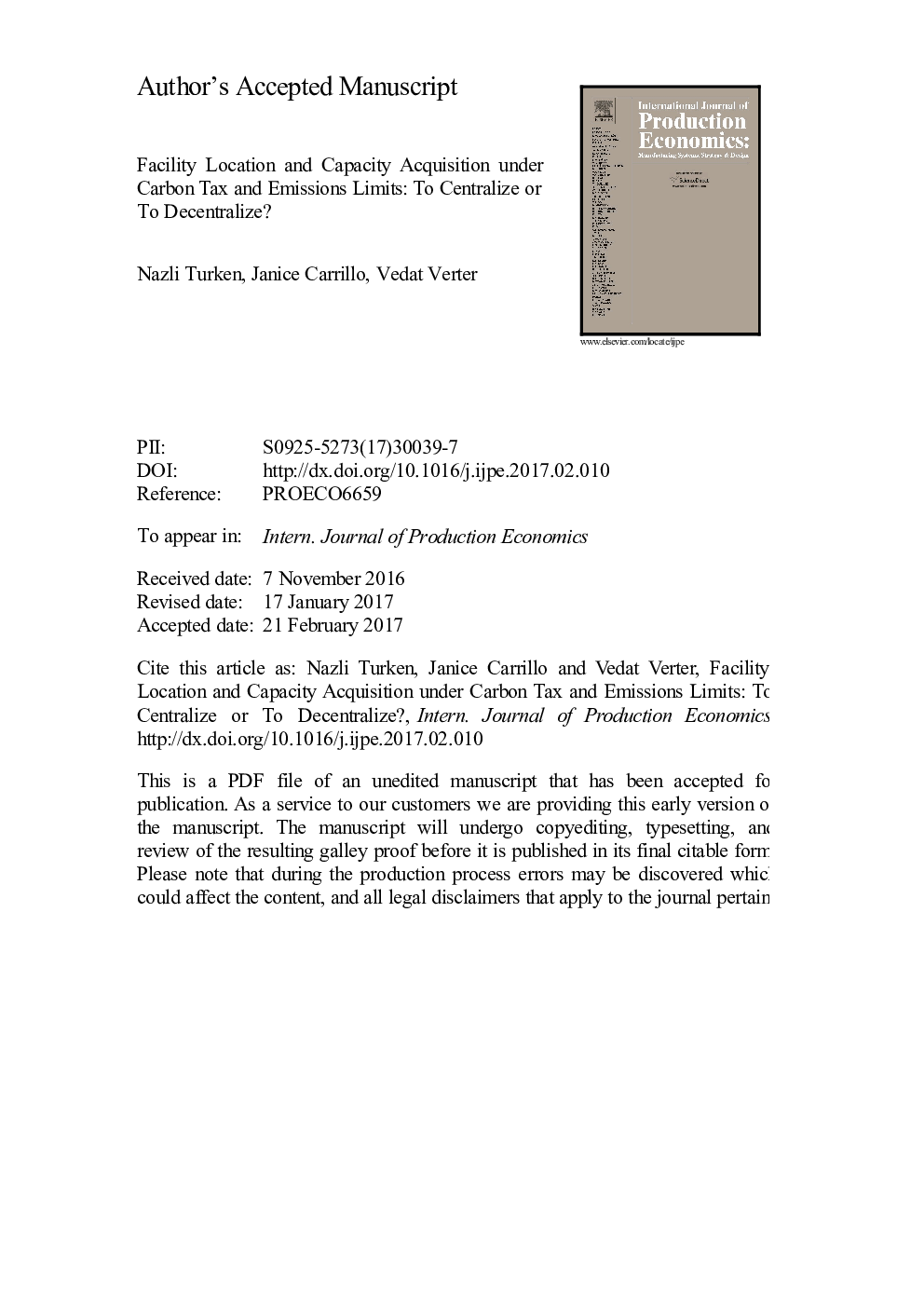| کد مقاله | کد نشریه | سال انتشار | مقاله انگلیسی | نسخه تمام متن |
|---|---|---|---|---|
| 5078955 | 1477517 | 2017 | 50 صفحه PDF | دانلود رایگان |
عنوان انگلیسی مقاله ISI
Facility location and capacity acquisition under carbon tax and emissions limits: To centralize or to decentralize?
ترجمه فارسی عنوان
مکان و امکانات تسهیلات تحت مالیات و مقررات انتشار گازهای کربن: برای متمرکز کردن یا عدم تمرکز؟
دانلود مقاله + سفارش ترجمه
دانلود مقاله ISI انگلیسی
رایگان برای ایرانیان
کلمات کلیدی
سلام، طراحی شبکه، مقررات محیطی،
ترجمه چکیده
ما بررسی تاثیر مقررات زیست محیطی در قالب یک مالیات بر کربن و قوانین فرماندهی و کنترل در مورد ظرفیت کارخانه و تصمیم گیری محل شرکت. در این زمینه، فرماندهی و کنترل شامل محدودیت در کل انتشار گازهای گلخانه ای و جریمه های مربوط به هر آلاینده است که این حد محدوده را افزایش می دهد، در حالی که مالیات بر کربن شامل هزینۀ متغیر برای انتشار است. ما همچنین دو گزینه سیاست جدید را پیشنهاد می کنیم که باید توسط سیاست گذاران برای حمل و نقل در نظر گرفته شود: (1) مجازات حمل و نقل به ازای هر واحد در هر کیلومتر؛ و (2) سیاست انتشار گازهای حمل و نقل جمعی با محدودیت در کل انتشارات حمل و نقل، شبکه های کارآمد شبکه. ما یک الگوریتم دقیق برای حل مشکل عددی غیر خطی ناشی از درهم آمیخته ای ایجاد می کنیم. ما همچنین نسخه های ساده ای از مشکل را برای به دست آوردن بینش های تحلیلی در مورد عوامل رانندگی راه حل ها برای سناریوهای دقیق تر و پیچیده تر در نظر می گیریم. ما یک مجموعه داده واقع بینانه از صنعت خودرو را که از منابع عمومی به دست آمده است، برای نشان دادن نتایج کلیدی این مدل توسعه می دهیم. با تجزیه و تحلیل داده های این نماینده، محدودیت های محیطی و مجازات هایی را که شرکت را به رعایت رعایت می کند شناسایی می کنیم. ما دریافتیم که مقررات سختگیرانه بدون مجازات بالا اطمینان از رعایت آن را ندارند، زیرا مزایای افزایش مقادیر مرتبط با یک گیاه متمرکز اغلب مجازات های مقرراتی را تحت تاثیر قرار می دهد. در سطح استراتژیک، مالیات بر تولید تولید، شرکتها را تشویق نمیکند تا میزان تولید تولید را کاهش دهند. با این حال، جریمه با مبلغ بالا با محدودیت های متوسط، تولید ناخالص داخلی و کل تولید حمل و نقل را کاهش می دهد. ما دریافتیم که برای تولید ناخالص تولیدی منطقه، در حالی که یک طرح فرماندهی و کنترل با یک تخفیف در مقادیر بالا برای جلوگیری از انتشار گازهای گلخانه ای موثر است، در هر واحد مالیات بر کربن اثر ندارد. جالب توجه است که مخالف برای کل انتشارات حمل و نقل صحت دارد، جایی که ما متوجه می شویم که مالیات بر مبنای حمل و نقل به ازای هر واحد در هر مایل موثر تر از یک طرح فرماندهی و کنترل است. در نهایت، ما همچنین می بینیم که شرکت هایی که آلودگی تولید کم، تقاضای کم یا هزینه های حمل و نقل بالا دارند باید تمرکززدایی را در راستای مقررات زیست محیطی در نظر بگیرند.
موضوعات مرتبط
مهندسی و علوم پایه
سایر رشته های مهندسی
مهندسی صنعتی و تولید
چکیده انگلیسی
We investigate the effect of environmental regulations in the form of a carbon tax and command-and-control legislation on plant capacity and location decisions of a firm. In this context, command-and-control involves a limit on the total emissions and penalties for any polluter exceeding this environmental limit, while carbon tax involves a variable cost for emissions. We also propose two novel policy options that should be considered by policy makers for transportation emissions: (1) a per unit per mile transportation penalty, and (2) a collective transportation emissions policy with a limit on total transportation emissions that encourages emission and cost efficient facility networks. We devise an exact algorithm to solve the arising discontinuous nonlinear integer problem. We also consider simplified versions of the problem to gain analytical insights on factors driving the solutions for the more accurate yet complex scenarios. We develop a realistic dataset from the auto industry gleaned from publicly available sources to highlight key results of the model. Through analysis of this representative data, we identify the environmental limits and penalties that would drive the company to compliance. We find that stricter regulations without high penalties would not assure compliance as the benefits of increased scale associated with a centralized plant frequently outweigh the regulatory penalties. At the strategic level, a production emissions tax does not encourage companies to reduce production emissions. However, high lump sum penalties with intermediate limits reduce both regional production and total transportation emissions. We find that for regional production emissions, while a command and control scheme with a high lump sum emissions penalty is effective in reducing emissions, a per unit carbon tax has no effect. Interestingly the opposite is true for total transportation emissions, where we observe that the per unit per mile transportation emissions tax is more effective than a command and control scheme. Finally, we also find that companies with low production pollution, low demand or high transportation costs should consider decentralization to comply with the environmental regulations.
ناشر
Database: Elsevier - ScienceDirect (ساینس دایرکت)
Journal: International Journal of Production Economics - Volume 187, May 2017, Pages 126-141
Journal: International Journal of Production Economics - Volume 187, May 2017, Pages 126-141
نویسندگان
Nazli Turken, Janice Carrillo, Vedat Verter,
